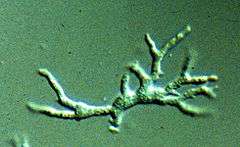Granulomatous amoebic encephalitis
| Granulomatous amoebic encephalitis | |
|---|---|
|
Balamuthia mandrillaris in its infectious, trophozoite form. | |
| Classification and external resources | |
| Specialty | Infectious disease |
| ICD-10 | A06.6 |
Granulomatous amoebic encephalitis ("GAE")[1] is a central nervous system disease caused by certain species,[2] especially species of Acanthamoeba and Balamuthia mandrillaris.[3][4]
The term is most commonly used with Acanthamoeba. In more modern references, the term "Balamuthia amoebic encephalitis" (BAE) is commonly used when Balamuthia mandrillaris is the cause.[5][6][7][8]
Pathology
GAE may present in numerous ways. There is no solid definition, as only a handful of patients have presented thus far with GAE. GAE can present with: focal paralysis, seizures, brainstem symptoms, and other neurological problems, some of which may mimic glioma (especially brainstem glioma), or other brain diseases, which may hamper timely diagnosis. These symptoms are caused by inflammatory necrosis of brain tissue brought on by amoebic infiltrates.
Appearance on biopsy
A brain biopsy will reveal the presence of infection by pathogenic amoebas. In GAE, these present as general inflammation and sparse granules. On microscopic examination, infiltrates of amoebic cysts and/or trophozoites will be visible.
Treatment
GAE, in general, must be treated by killing the pathogenic amoebas which cause it.
Acanthamoeba
Even with treatment, the condition is often fatal, and there are very few recorded survivors, almost all of whom suffered permanent neurocognitive deficits. Antifungal drugs including ketoconazole, miconazole, 5-flucytosine and pentamidine have been shown to be effective against GAE-causing organisms in laboratory tests.[9]
Balamuthia
In one case, cloxacillin, ceftriaxone, and amphotericin B were tried.[10]
Two patients survived after being successfully treated with a therapy consisting of flucytosine, pentamidine, fluconazole, sulfadiazine and azithromycin. Thioridazine was also given. Successful treatment in these cases was credited to "awareness of Balamuthia as the causative agent of encephalitis and early initiation of antimicrobial therapy."[11]
References
- ↑ Sarica, F. B.; Tufan, K.; Cekinmez, M.; Erdoğan, B.; Altinörs, M. N. (2009). "A rare but fatal case of granulomatous amebic encephalitis with brain abscess: the first case reported from Turkey". Turkish neurosurgery 19 (3): 256–259. PMID 19621290.
- ↑ "Amebic Meningoencephalitis: Overview - eMedicine".
- ↑ Guarner, J.; Bartlett, J.; Shieh, W.; Paddock, C.; Visvesvara, G.; Zaki, S. (2007). "Histopathologic spectrum and immunohistochemical diagnosis of amebic meningoencephalitis". Modern pathology : an official journal of the United States and Canadian Academy of Pathology, Inc 20 (12): 1230–1237. doi:10.1038/modpathol.3800973. PMID 17932496.
- ↑ Jayasekera, S.; Sissons, J.; Tucker, J.; Rogers, C.; Nolder, D.; Warhurst, D.; Alsam, S.; White, J. M.; Higgins, E. M.; Khan, N. A. (2004). "Post-mortem culture of Balamuthia mandrillaris from the brain and cerebrospinal fluid of a case of granulomatous amoebic meningoencephalitis, using human brain microvascular endothelial cells". Journal of medical microbiology 53 (Pt 10): 1007–1012. doi:10.1099/jmm.0.45721-0. PMID 15358823.
- ↑ Da Rocha-Azevedo, B.; Tanowitz, H.; Marciano-Cabral, F. (2009). "Diagnosis of infections caused by pathogenic free-living amoebae". Interdisciplinary perspectives on infectious diseases 2009: 251406. doi:10.1155/2009/251406. PMC 2719787. PMID 19657454.
- ↑ Matin, A.; Siddiqui, R.; Jung, S.; Kim, K.; Stins, M.; Khan, N. (2007). "Balamuthia mandrillaris interactions with human brain microvascular endothelial cells in vitro". Journal of medical microbiology 56 (Pt 8): 1110–1115. doi:10.1099/jmm.0.47134-0. PMID 17644721.
- ↑ Siddiqui, R.; Khan, N. (2008). "Balamuthia amoebic encephalitis: an emerging disease with fatal consequences". Microbial pathogenesis 44 (2): 89–97. doi:10.1016/j.micpath.2007.06.008. PMID 17913450.
- ↑ Schuster, F.; Yagi, S.; Gavali, S.; Michelson, D.; Raghavan, R.; Blomquist, I.; Glastonbury, C.; Bollen, A.; Scharnhorst, D.; Reed, S. L.; Kuriyama, S.; Visvesvara, G. S.; Glaser, C. A. (2009). "Under the radar: balamuthia amebic encephalitis". Clinical Infectious Diseases 48 (7): 879–887. doi:10.1086/597260. PMID 19236272.
- ↑ Final Diagnosis - Case 156
- ↑ Intalapaporn P, Suankratay C, Shuangshoti S, Phantumchinda K, Keelawat S, Wilde H (1 June 2004). "Balamuthia mandrillaris meningoencephalitis: the first case in southeast Asia". Am. J. Trop. Med. Hyg. 70 (6): 666–9. PMID 15211011.
- ↑ Deetz TR, Sawyer MH, Billman G, Schuster FL, Visvesvara GS (2003). "Successful treatment of Balamuthia amoebic encephalitis: presentation of 2 cases". Clinical Infectious Diseases 37 (10): 1304–12. doi:10.1086/379020. PMID 14583863.
| ||||||||||||||||
